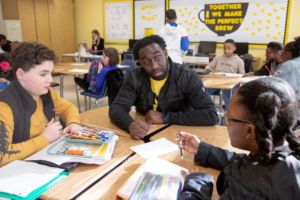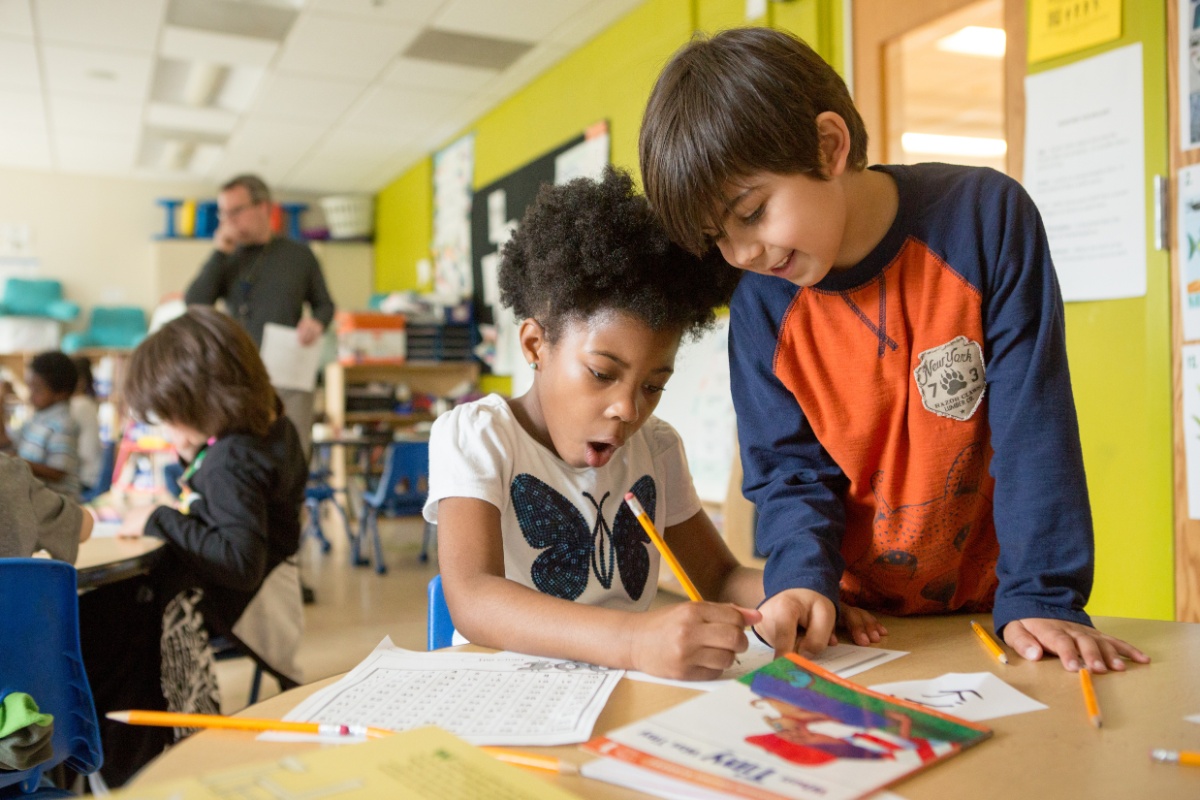In my September blog post, I wrote about how I became a “math person.” I literally went from someone who didn’t like math AT ALL, to someone who teaches people how to teach math. Reading, and how to teach reading in the most engaging ways, played an enormous role in this process. Here are five (of many) things I applied from the teaching of reading to make my math instruction exceedingly better!
Asking questions puts a whole new spin on teaching and learning

I spent years studying the teaching of reading and writing. I delved into word study, comprehension development, and book clubs. I learned how to write about reading and analyze books, the characters within, how they interact with each other, and what their impact is on the story. The one concept of teaching that was prevalent across all of those components of reading was asking questions. Rather than telling my students how to think about the characters, I asked them what they thought. Rather than telling students what they should write about in their reading notebooks, I asked them what was standing out to them the most about the story they were reading. I was the facilitator of their learning, and by engaging them in a more inquiry based process, they became the owners of their reading, empowered to interpret and connect to books in ways that made sense to them. One of the first changes I made in my math classroom was asking questions instead of talking at them. Rather than standing in front of them giving them steps to solve a problem, I asked them how to solve the problem in a way that made sense to them, and then used questions to clarify their thinking. I posed solutions to them and asked them to make observations. When they solved problems in ways I didn’t understand, rather than telling them to try it a different way, I asked them to tell me more about their thinking. My mathematics classroom came to life through the simple shift of asking questions about the math rather than telling my students how to think. They authentically didn’t want steps. They wanted to understand the process. They suddenly had access to math, and that is what it is all about.
Connecting to prior knowledge provides opportunity for authentic engagement
I remember learning about using a child’s schema to help them connect to the text they were reading. This requires a lot of work. Who are my students? What are their interests? What do they do when they aren’t in school? How can I select texts to which they can relate and connect in order to authentically engage with the text? How do they see themselves in their reading? When we teach math, these same notions are true. Not only must we connect math to their lives and provide them with authentic real world problems to solve, we must build on their prior knowledge so they can understand how new skills and concepts relate to what they already know. Introducing new ideas outside of context or without connecting to prior knowledge can almost immediately shut children down, and that is the opposite of what we want our students doing in math class – or any other content area in our classrooms.
They authentically didn’t want steps. They wanted to understand the process. They suddenly had access to math, and that is what it is all about.
A good debate empowers children to own their learning

I remember one of the first times I implemented book clubs in my classroom. I was married to the author of Making the Work Interesting: Classroom Management Through Ownership in Elementary Literature Circles, and knew I needed to truly work on helping my students understand what it means to have a conversation about books. Going through this process was essential to the success of my book clubs. I absolutely loved listening to them debate opinions on why characters made certain decisions or predictions of what they thought might happen next. This is why we teach reading – to help children learn how to read to inform their viewpoints and then engage in critical conversations to determine an educated stance on issues in our world. Now, there are amazing books about productive classroom discourse in our mathematics classrooms. Back then, I didn’t know “talking about math” was a thing, but I did know it worked really well in reading, so why shouldn’t I do the work to make it happen in my math classroom as well? I opted to use what I knew about engaging my students in reading conversations to encourage them to do the same during math class. I can still remember one of the first times a debate began in my classroom. One student was seeing the solution to a problem one way, another a different way. They went back and forth explaining their thinking, pointing out how they documented their thinking on paper. I stood back. Let it happen. Listened carefully. When they came to a pause, they looked at me as if to say, “So? Who’s right?” I immediately posed a question to the rest of the class – “who do you think is right?” The consensus? They both were, because there are multiple ways to think about and solve the problem. Let them debate. We are teaching them to be critical thinkers, and critical thinking comes from discourse and debate.
You always need evidence to support your answer
In teaching reading, an acceptable answer is never, “Because it says so on page 22.” We ask students to cite specific examples and evidence from the text to support their answers. Without which, their answer is incomplete. In math, we must do the same. An acceptable answer is never, “Because I followed the steps and it got me the right answer. “ Or, “Because that’s how my teacher told me to solve the problem.” Or, “I know the answer because I’ve passed my 4s, so I know them.” In math, children need to be able to explain their mathematical thinking. They need to know what math they used to arrive at their answer – not what steps they followed to get there. If they can’t explain the math, they don’t have evidence to support their answer, and we as teachers have more work to do.
We are teaching them to be critical thinkers, and critical thinking comes from discourse and debate.
Fluency has nothing to do with speed
In reading, a child may be able to read a text quickly. They might even say all of the words correctly. However, if they can’t answer any questions about what they read, they are not fluent. Saying words alone isn’t reading. It certainly is a start, but unless children can comprehend what they have read, they aren’t really fluently reading. Children need to know what they are reading so they can be critical thinkers. Saying words doesn’t create critical thinkers. In math, if a child can say answers to basic facts quickly, but can’t explain how they arrived at their answer, they are not fluent. Do we want children to be efficient? Yes. However, procedural fluency is the result of a child understanding there are multiple ways to arrive at a solution, can choose the most efficient strategy to solve the problem in a reasonable amount of time, and not only gets an accurate answer but can accurately explain how they arrived at that answer. Children need to know how the math works so they can connect it to new concepts and be critical thinkers. Quickly providing answers to problems doesn’t create critical thinkers. Pedagogical principles in various content areas do not live in isolation. If you find something working really well in one content area, how might you apply it to another to enhance the learning experience of your students? Recently a teacher said to me, “Why do I have them sit on the carpet and turn and talk during reading, but I never do that in math?” My response, “I’m not sure. Why don’t you do that?” Her reply, “I just always thought about math as being something they do at their desks. But, they are so engaged whenever we are on the carpet.” My baby step for her was – move to the carpet for math sometimes OR hey – you can have them turn and talk when they are at their desks too! Think about a content area you feel very comfortable teaching. What pedagogical moves do you make that have great success? How might you be able to emulate those moves in math to see your students come alive? Choose one little thing and take that baby step!
Resources
Please login or register to claim PGPs.
Alternatively, you may use the PGP Request Form if you prefer to not register an account.



